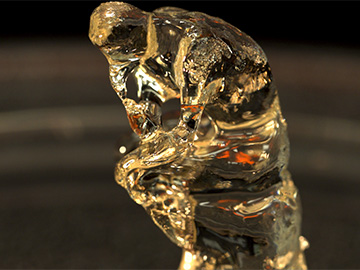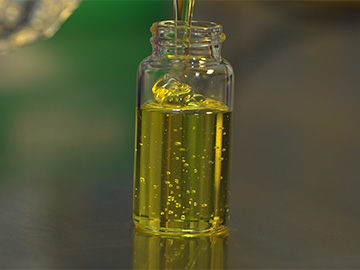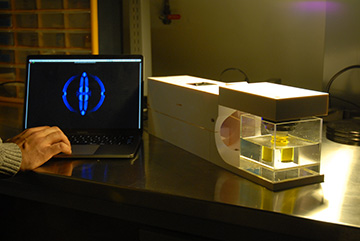
The LLNL–Berkeley team created a variety of centimeter-scale solid objects, including a tiny model of Rodin’s The Thinker, using a new light-activated volumetric 3-D-printing method. [Image: Stephen McNally, U.C. Berkeley]
Using a simple setup consisting of an off-the-shelf digital projector, a rotating transparent drum and a laptop computer, engineers at the Lawrence Livermore National Laboratory (LLNL) and the University of California Berkeley, USA, have devised an additive-manufacturing system that can reportedly create small, complex 3-D objects at blistering rates compared with conventional, layer-by-layer 3-D-printing approaches (Science, doi: 10.1126/science.aau7114).
The system works by spraying patterned light from the projector onto the rotating drum, which is filled with clear photosensitive resin designed to solidify when exposed to illumination above a threshold intensity—yielding a solid object after one revolution of the drum. Using the system, the team was able to create a diminutive, centimeter-scale replica of Auguste Rodin’s celebrated sculpture The Thinker, a customized dental model, and other small objects in 30 to 120 seconds.
That’s several orders of magnitude faster, according to the researchers, than layer-by-layer methods of 3-D printing. Moreover, the team notes that its method can work with a wider range of materials, from high-viscosity resins to hydrogels, and can even be used to encase pre-existing objects with additional components (such as adding a plastic handle to a metal screwdriver shaft).
Reverse CT scan
In the system, a succession of 2-D images is projected by a digital projector onto a rotating drum filled with a photocurable polymer, tuned to solidify when hit by light above a threshold intensity. [Image: Hayden Taylor] [Enlarge image]
Conventional additive-manufacturing systems build up 3-D models layer by layer, in a process that is sometimes glacially slow. While recent innovations, such as curing entire layers at once and fine-tuning the curing process, have sped things up considerably, the fundamentally layer-by-layer process still represents a practical speed limit. It also means that some 3-D printed objects include micro-scale artifacts, like stair-step effects on their edges.
The LLNL–Berkeley team, led by mechanical engineering professor Hayden Taylor, considered another approach: a sort of reverse computed-tomography (CT) scan. In a CT scan, electromagnetic radiation, such as X-rays, is projected onto the subject from a variety of different angles, and a model of the physical geometry—including things like hidden tumors—is mathematically reconstructed from the scan data.
To develop its volumetric printer, the LLNL–Berkeley researchers turned that approach on its head, beginning with a carefully calculated mathematical model of the object. They then used that model to spawn a large stack of 2-D digital images showing the object as illuminated from different angles.
Projecting each image in succession, as patterned light from the projector onto the rotating drum, creates an optical energy dose that maps to the specific geometry of the object at each angle. The approach, according to the researchers, is analogous to intensity-modulated radiation therapy, which creates a 3-D radiation exposure inside the patient’s body, but targets the critical dose to the tumor location and keeps the dose below the critical threshold elsewhere.
Resin recipe

The viscous polymer includes dissolved oxygen to inhibit initial curing until a threshold intensity is reached. [Image: Stephen McNally, U.C. Berkeley]
With the system geometry set up, the next step in the research took place in the chemistry lab, to develop a photosensitive resin that would solidify only when illuminated by light at a certain threshold intensity and wavelength. The team achieved that by mixing several commercially available photopolymers and photoinitiators, tweaking the specific components and concentrations to hammer down the resulting resin’s absorption coefficient at the illuminating wavelength. The resin is then impregnated with dissolved oxygen—the “secret sauce” that sets the critical illumination dose.
When patterned light hits the viscous, uncured polymer resin in the rotating drum, the light activation creates free radicals that are quickly sopped up by the dissolved oxygen, which initially inhibits solidification. If the local light dose in a volume of the material is above the critical threshold, however, the oxygen is completely depleted, and the polymer molecules start to cross-link, transforming the resin from liquid to solid in that volume. As an extra bonus, any unused resin after 3-D printing an object can be “recharged” and reused by heating the resin in an oxygen-rich atmosphere.
Single-rotation build
The research team used the process to create a variety of centimeter-scale objects on one- to two-minute timescales, and in materials ranging from solid plastics to custom hydrogels—each built all at once in a single rotation of the drum. A video from the Berkeley lab showed the process in action:
In addition to the unusually rapid printing times, the researchers point out that the system allows the use of higher-viscosity resins than those in layer-by-layer approaches, which must be runny enough to flow into the thin area where layer curing takes place. And, while the objects demonstrated thus far have been on the centimeter scale, the team writes that the method “is inherently scalable to larger print volumes, with components having diameters of ~0.5 m and submillimeter features,” by adjusting the projector power and the absorption coefficients of the resin.
Multi-material fabrication
The researchers also note that the system’s ability to add plastic components that encase pre-existing objects opens the door to multi-material fabrication workflows—a difficult hurdle for previous additive-manufacturing systems to overcome.
“I think this is a route to being able to mass-customize objects even more, whether they are prosthetics or running shoes," the team leader, Taylor, observed in a press release accompanying the research. “The fact that you could take a metallic component or something from another manufacturing process and add on customizable geometry, I think that may change the way products are designed.”

